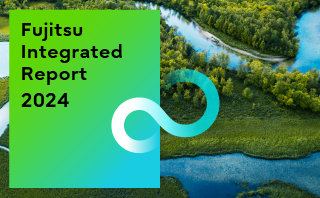-
Sustainability at Fujitsu Group
- Sustainability Management in the Fujitsu Group
- GRB(Global Responsible Business)Goals and Achievments for FY2022
- GRB(Global Responsible Business)Goals for FY2025
- Fujitsu's accessibility
- Stakeholder Engagement
- United Nations Global Compact
- SDG-related Activities in Fujitsu
- External Recognition and Awards
-
Global Responsible Business
- Environment
-
- Environmental Management
- The Fujitsu Group Environmental Vision on Climate Change
- Living in Harmony with Nature (Conservation of Biodiversity)
- Environmental Action Plan
- Environmental Data
- Environmental Communication
- Environmental Social Activities
- Disposal and Recycling of ICT products
- Environmental Considerations in ICT Products
- Governance
-
Data and Documents
- Fujitsu Group Sustainability Data Book 2024
- Social, Governance and Environmental data
- Independent Assurance Report

- GRI Standards / United Nations Global Compact (UNGC) principles Comparison Table
- SASB Standards Comparison Table
- Sustainability Information Disclosure Framework
- Link to regions responsible business reports
- Contact
- Sitemap
Case Studies
Increasing Amounts of Renewable Energy Used
Renewable Energy Initiative in Australia (FY2022)
Fujitsu Australia signed a power purchase agreement to procure renewable energy through the Sapphire Wind Farm operated by CWP Renewables. Beginning in June 2022, Fujitsu Australia has covered approximately 40% of its data center electricity with renewable sources. This equates to around 30% of the company’s total annual electricity consumption, and offsets approximately 30,000 tons of its annual greenhouse gas emissions.
https://www.fujitsu.com/au/about/resources/news/press-releases/2022/fal-signs-first-ppa-to-help-reduce-carbon-emissions.html
Introduction of Green Power (FY2021)
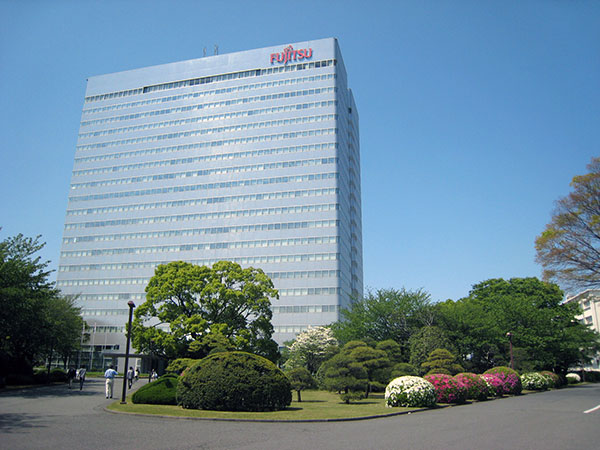 Kawasaki Main Office
Kawasaki Main Office
At Fujitsu, in addition to switching the Kawasaki Main Office to 100% renewable energy, we procured approximately 115 GWh of renewable energy at domestic plants, business sites and other locations.
Introduction of Green Power (FY2020)
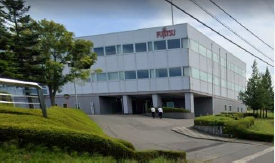 Aomori System Laboratory
Aomori System Laboratory
At Fujitsu, from FY 2020, we switched approximately 3 GWh of the electric power used at three system laboratories—in Aomori, Kumamoto, and Oita—to 100% renewable energy.
Introduction of Solar Panels (FY2019)
At Fujitsu Consulting India (FCI) Private Limited in India, we introduced solar panels with an electric power generation capacity of 350kW, in order to reduce electricity use and control peak electricity. The panels began generating electricity from January 2019.
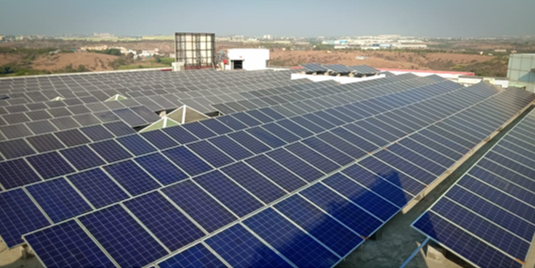
Exterior of FCI solar panels
Joint Research with Kawasaki City for a Renewable Energy Regional Cooperation Model (FY2017)
With the goal of reducing greenhouse gas emissions amount, the entire Fujitsu Group has worked to achieve a low-carbon society. However, it is difficult to expect significant results by merely extending existing measures in which corporations work individually to reduce environmental load. It is necessary to evolve future environmental activities in order to realize collaboration and co-creation that will overcome various barriers such as industrial regions.
Therefore, in July 2017, we started research on a “renewable energy regional cooperation model” in collaboration with Kawasaki city, which is the location of the Fujitsu Main Office. The research is aimed at efficient usage of renewable energy in the region. In FY 2017, in addition to creating a map of renewable energy generation sites in the city, we used an environmental energy simulator developed with a British corporation to review the energy supply and demand balance in seven districts of Kawasaki city. In FY 2018, by constructing a precision model of areas around Kawasaki Station and Musashi-Kosugi Station and simulating the effect of implementing solar and wind power generation facilities, we plan to conduct even more detailed review for implementation of renewable energy.
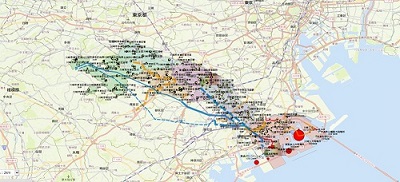
Map of renewable energy generation sites in Kawasaki city
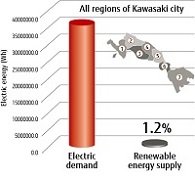
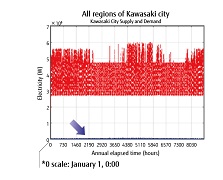
Results of energy simulation in Kawasaki city
100% Renewable Energy Usage in Finland Data Centers and Offices (FY2015)
At Fujitsu Finland, we have been using 100% renewable energy from hydroelectric power since April 2014 in our 4 data centers, a distribution center, offices and some other facilities.
The amount of renewable energy purchased in FY 2015 was 28,000 MWh.
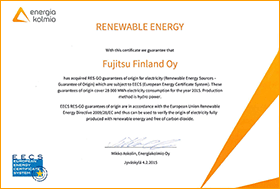
Green power certificate
Concluding an Agreement to Purchase Solar Generated Electricity in the U.K. (FY2014)
Fujitsu UK & Ireland has concluded an agreement to purchase electric power generated by a photovoltaic system installed on the roof of their office building by LCPF. The panels were installed in February and March 2014 and have been operating since April of the same year.
In the half-year up to September 2014, the system generated 34,907 kWh of electricity, which was equivalent to 3.5% of the total power consumption on site.
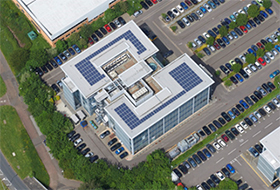
Rooftops with solar panels installed
Microgrid Verification Tests at the Kawasaki Plant (FY2013)
Solar power generation that has rapidly spread in recent years has the advantage of addressing peak periods of power consumption because it generates more power during the high demand times of mid-day and during the summer. However, power output changes greatly with fluctuations in the weather, making it difficult to effectively use solar power to meet demand. With this challenge in mind, Fujitsu developed technology for optimizing battery usage so that solar power can be effectively used to mitigate peak periods of power consumption.
This technology predicts over 10,000 scenarios simulating a variety of possible supply and demand situations based on the weather. Using these scenarios, plans for optimum battery usage are created in advance and stored in a database that selects and changes plans in response to supply and demand for power. In verification tests of the system at the Kawasaki Plant, peak periods of power consumption were mitigated an average of 23% during the operation period from July 2012 to June 2013. We were also able to confirm that repeatedly altering battery usage plans can steadily improve the effects of mitigating peak periods.
This battery optimizing and control technology is one of the results of projects that Fujitsu has quickly adopted in-house as part of our effort to effectively utilize a microgrid for bringing about local production and local consumption of green energy. The microgrid makes use of small, dispersed power sources, combined with batteries and other technology. Going forward, we will strive to develop further technology for effectively utilizing inherently intermittent natural energy.
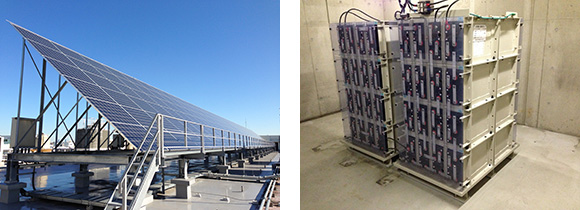
Solar panels and batteries used in the verification tests
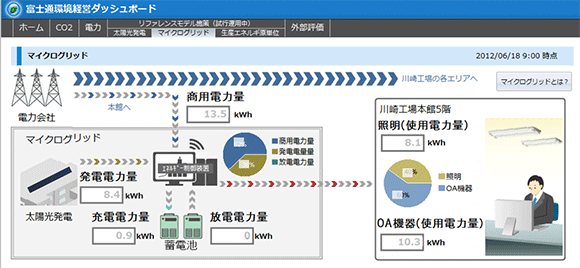
Dashboard showing the operating status of our microgrid
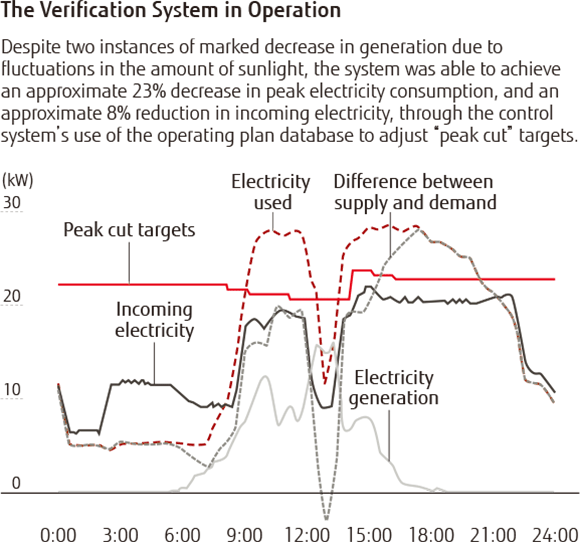
Installing Solar Power Generation Facilities(Fujitsu Wireless Systems Limited) (FY2013)
In October 2013, we installed solar power generation facilities with generation capacity of 200 kW at the Kumagaya Plant, Fujitsu Wireless Systems Limited, in order to reduce our amount of power consumption and limit peak periods of consumption. We are trying out various approaches, such as spreading water on the solar panels to keep their surfaces from overheating, to maintain maximum power generation efficiency. As a result of installing the facilities, we have been able to reduce power usage at the entire plant by approximately 10%.
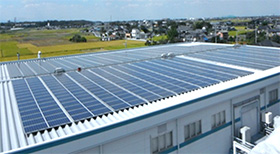
Solar panels at Fujitsu Wireless Systems Limited
Geothermal Heat Extraction System (FY2011)
Renewable energy has been garnering increasing attention not only for reducing CO2 emissions but also for lessening energy supply-related risks. The Group has deployed and is evaluating the performance of its first geothermal heat extraction system at the Nagano Plant in Japan.

